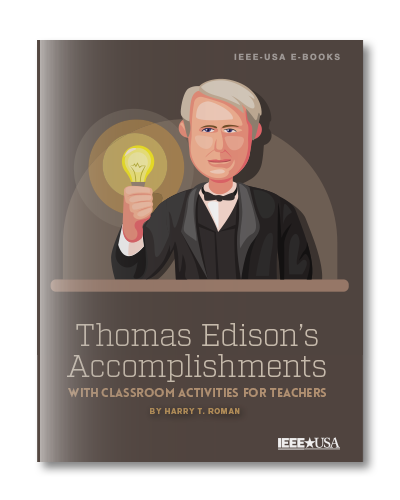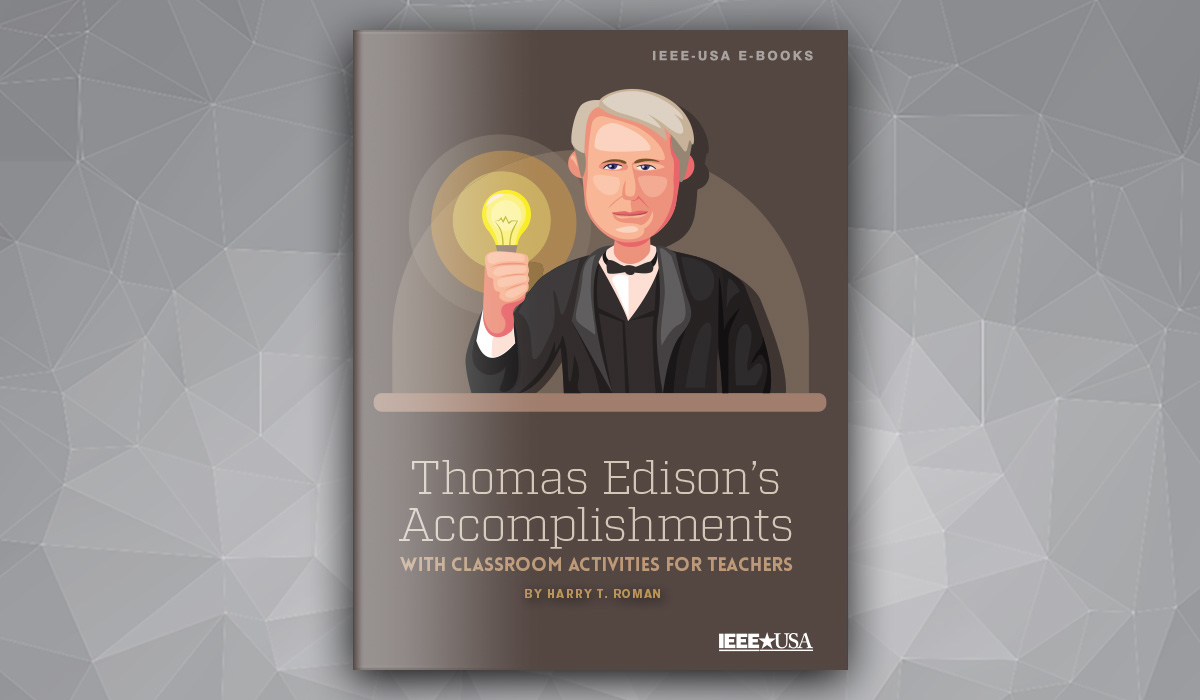
Thomas Edison’s Accomplishments with Classroom Activities for Teachers
FREE to IEEE Members
Non-Members: $2.99
Harry T. Roman has written three IEEE-USA e-books on Thomas Edison’s life, serves as an advisor/author to the Edison Innovation Foundation, is active as a docent/special lecturer at the Thomas Edison National Historical Park — and now has written the just-released IEEE-USA e-book, Thomas Edison’s Accomplishments With Classroom Activities for Teachers. I think it is safe to say that Roman is an “Edisonophile” (lover of all things Thomas Edison).
Roman’s respect and admiration for the great inventor is as much for Edison’s ability to build businesses based on his inventions, as the inventions themselves. Roman notes economists estimate $10-$12 trillion of today’s $90 trillion world economy is built on Edison’s work, as well as fully a quarter of all the current jobs on the planet.
For Roman, Edison’s establishment of a research and development model modern R&D labs still follow may have been the great inventor’s most important invention. The author stresses that these labs still drive innovation today; but, importantly, also drive the commercialization of those innovations. One of the questions he encourages students to explore is the differences and similarities between inventors and entrepreneurs.
Roman firmly believes that Edison deserves special recognition in STEM education. “As children work their way through the engineering design process and work in student teams in their STEM classes, they are mimicking what Edison and his staff did in creating the cornucopia of products that emanated from his labs and factories.”
Thomas Edison’s Accomplishments with Classroom Activities for Teachers is chock full of information on Edison and his inventions, along with scores of activities a teacher (or parent) can use to foster greater understanding of the ongoing impact Edison’s inventions continue to have today.
Roman starts off with Edison’s prolific inventing, highlighting the inventor had 1,093 U.S. patents, and another 1,293 foreign patents. He suggests teachers can lead a discussion on patents — asking such questions as:
- What is a patent, and why are they important?
- Where did the idea of patents originate, and why?
- About how many U.S. patents are currently in existence, and what national organization is responsible for cataloguing and maintaining patent files?
Roman outlines the diversity of Edison’s inventions; including recorded sound, motion pictures, lightbulbs, electric utility systems, and storage batteries. He also includes lesser known ones — like the talking doll, stock ticker, typewriter and miner’s hat with electric safety lamp, as well as a dictation system, a fruit preservation system, and coining the word, “Hello.”
After outlining the eight categories Edison’s inventions fall under, he gives the teacher or parent a number of questions they can explore with students, including:
- What was Edison’s greatest invention, and why?
- Look at your smart phone; which of Edison’s inventions are embedded in it?
- How did the light bulb change everyday life? Were there any negative impacts?
- Why did Edison have his experts work in project teams?
- Edison’s batteries were very different from the acid-based batteries existing at the time. How did Edison’s alkaline batteries change the market?
- Do any modern-day inventors work across diverse areas?
- Edison had significantly diminished hearing capacity. How do you account for his communications-related patents?
Roman also encourages teachers to have students follow Edison’s example by creating “inventions notebooks.” He outlines the benefits of these notebooks and the elements students could include in them.
Thomas Edison’s Accomplishments with Classroom Activities for Teachers is available for free for IEEE members at the IEEE-USA shop; non-members pay $2.99.
Harry T. Roman is an inventor himself, holding 12 patents. The New Jersey Inventors Hall of Fame honored him with an Inventor of the Year award for his application of mobile robots in hazardous work environments, and the New Jersey Technology Education and Engineering Association named him a Distinguished Technology Educator. Roman has received several IEEE awards, including a Meritorious Achievement Award, for developing continuing education products for IEEE members, an Outstanding Engineer Award, and a regional Excellence in Teaching award.
